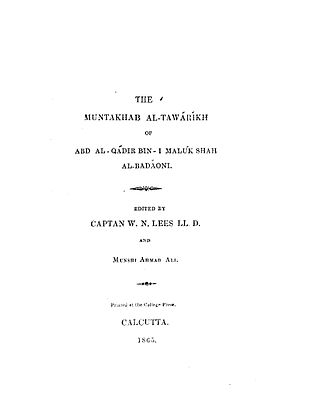Related Research Articles

The Chishtī Order is a tariqa, an order or school within the mystic Sufi tradition of Sunni Islam. The Chishti Order is known for its emphasis on love, tolerance, and openness. It began with Abu Ishaq Shami in Chisht, circa 930 AD in a small town near Herat, a strategic city in then Eastern Persia, which later became independent and then part of Afghanistan.

Sultan-ul-Mashaikh, Khwaja Syed Muhammad Nizamuddin Auliya, also known as Hazrat Nizamuddin, and Mahbub-e-Ilahi was an Indian Sunni Muslim scholar, Sufi saint of the Chishti Order, and is one of the most famous Sufis from the Indian Subcontinent. His predecessors were Fariduddin Ganjshakar, Qutbuddin Bakhtiyar Kaki, and Moinuddin Chishti, who were the masters of the Chishti spiritual chain or silsila in the Indian subcontinent.

Chishtī Muʿīn al-Dīn Ḥasan Sijzī (1143–1236), known more commonly as Muʿīn al-Dīn Chishtī or Moinuddin Chishti, or by the epithet Gharib Nawaz, or reverently as Shaykh Muʿīn al-Dīn or Khwāja Muʿīn al-Dīn, was a Sunni Muslim preacher, ascetic, religious scholar, philosopher and mystic from Sistan, who eventually ended up settling in the Indian subcontinent in the early 13th-century, where he promulgated the famous Chishtiyya order of Sunni mysticism. This particular tariqa (order) became the dominant Islamic spiritual order in medieval India. Most of the Indian Sunni saints are Chishti in their affiliation, including Nizamuddin Awliya and Amir Khusrow.

Shams ud-Din Iltutmish was the third of the Mamluk kings who ruled the former Ghurid territories in northern India. He was the first Muslim sovereign to rule from Delhi, and is thus considered the effective founder of the Delhi Sultanate.

Abu'l-Fazl ibn Mubarak, also known as Abul Fazl, Abu'l Fadl and Abu'l-Fadl 'Allami, was an Indian writer, historian, and politician who served as the grand vizier of the Mughal Empire from his appointment in 1579, until his death in 1602. His notable works include the Akbarnama, Ain-i-Akbari, and a Persian translation of the Bible.

The Akbarnama, is the official chronicle of the reign of Akbar, the third Mughal Emperor, commissioned by Akbar himself and written by his court historian and biographer, Abul Fazl. It was written in Persian, which was the literary language of the Mughals, and includes vivid and detailed descriptions of his life and times. It followed the Baburnama, the more personal memoir by his grandfather, Babur, founder of the dynasty. It was produced in the form of lavishly illustrated manuscripts.
The History of India, as Told by Its Own Historians is a book comprising translations of medieval Persian chronicles based on the work of Henry Miers Elliot. It was originally published as a set of eight volumes between 1867–1877 in London. The translations were in part overseen by Elliot, whose efforts were then extended and edited posthumously by John Dowson.

Quṭb al-Aqṭāb Khwāja Sayyid Muḥammad Bakhtiyār al-Ḥusaynī, Quṭb al-Dīn Bakhtiyār Kākī was a Sunni Muslim Sufi mystic, saint and scholar of the Chishti Order from Delhi, India. He was the disciple and the spiritual successor of Mu'in al-Din Chishti as head of the Chishti order. Before him the Chishti order in India was confined to Ajmer and Nagaur. He played a major role in establishing the order securely in Delhi. His dargah located adjacent to Zafar Mahal in Mehrauli, and the oldest dargah in Delhi, is also the venue of his annual Urs festivities. The Urs was held in high regard by many rulers of Delhi like Iltutmish who built a nearby stepwell, Gandhak ki Baoli for him, Sher Shah Suri who built a grand gateway, Bahadur Shah I who built the Moti Masjid mosque nearby and Farrukhsiyar who added a marble screen and a mosque.
Brajendranath Dey was an early Indian member of the Indian Civil Service.

The Ain-i-Akbari or the "Administration of Akbar", is a 16th-century detailed document regarding the administration of the Mughal Empire under Emperor Akbar, written by his court historian, Abu'l Fazl in the Persian language. It forms Volume III and the final part of the much larger document, the Akbarnama, also by Abu'l-Fazl, and is itself in three volumes.
The Farooqi dynasty was the ruling dynasty of the Khandesh Sultanate from its inception in 1382 till its annexation by the Mughal emperor Akbar in 1601. The founder of the dynasty, Malik Ahmad participated in a rebellion against the Bahmani ruler Muhmmad Shah I in his early years. When he was compelled to flee from Deccan, he established in Thalner on the Tapti River. After receiving the grant of the fiefdoms of Thalner and Karanda from Firuz Shah Tughluq in 1370, he conquered the region around Thalner, which later became known as Khandesh. By 1382, he started ruling independently.

The Berar Subah was one of the Subahs of the Mughal Empire, the first to be added to the original twelve, in Dakhin from 1596 to 1724. It bordered Golconda, Ahmandagar, Kandesh and Malwa subahs as well as the independent and tributary chiefdoms to the east.
Shaikh Gadai Kamboh was the son, disciple and successor of famous scholar, philosopher and poet-laureate Shaikh Jamali Kamboh of Delhi and brother of the 'Master of Expression' —Shaikh Abd-al-Hai Hayati. His real name was Abdur Rehman but he became famous as Gadai. He was well-renowned for his sanctity and learning and was in high favour with emperor Humayun and Bairam Khan. He is also said to have remained a Musahib of the Afghan emperor Salim Shah Suri. During Akbar’s reign, he occupied the high office of “Sadr-i-sadur” of Hindustan.
Nizam al-Din, spelled variously Nizamuddin or Nizamüddin or etc. may refer to:
In the winter of 1297, Kadar, a noyan of the Mongol Chagatai Khanate invaded the Delhi Sultanate ruled by Alauddin Khalji. The Mongols ravaged the Punjab region of modern day Pakistan and India, advancing as far as Kasur. Alauddin sent an army led by his brother Ulugh Khan to check their advance. This army defeated the invaders on 6 February 1298, killing around 20,000 of them, and forcing the Mongols to retreat.
Khulasat-ut-Tawarikh is a Persian language chronicle written by Sujan Rai in the Mughal Empire of present-day India. It deals with the history of Hindustan, and it also contains details about the contemporary Mughal Empire. Sujan Rai completed the book in 1695 CE, during the reign of Aurangzeb. An insertion about Aurangzeb's death was later added to the original copy by a transcriber.

Muntakhab-ut-Tawarikh orTarikh-i-Bada'uni, Selection of Chronicles by `Abd al-Qadir Bada'uni (1540–1605) is a book describing the early Mughal history of India, covering the period from the days of Ghaznavid reign until the fortieth regnal year of Mughal Emperor Akbar.
Ali Shah born Alī Shāh Chak was the third Chak Sultan succeeding his brother Husain Shah Chak who abdicated the throne in 1570. He was crowned as the 31st Sultan of Kashmir and ruled the Sultanate till 1578. Ali Shah appointed his long time faithful friend Sayyid Mubarak as his Wazīr. He died in December 1578 and was buried in Srinagar, Kashmir.
Yakub, born Ya'qūb (Yākūb) Shāh Chak was the seventh and the last Chak Sultan as well as the last native ruler of Kashmir, who reigned from 1586 to 1589. Yaqub succeeded his father, Yousuf Shah Chak, under warlike conditions, after Kashmir was invaded by the Mughal forces in late 1585.
References
- Brajendranath De; Baini Prashad (eds.) The Ṭabaqāt-i-Akbarī of K̲h̲wājah Nizāmuddīn Ahmad : a history of India from the early Musalman invasions to the thirty-sixth year of the reign of Akbar by Niẓām al-Dīn Aḥmad ibn Muḥammad Muqīm; Calcutta : Asiatic Society, 1927, 1973 (3 vols.)
- Nizamuddin Ahmad, Khwajah. The ṭabaqāt-i-Akbarī. Edited by Brajendranath De and M. Hidayat Hosein. 3 vols. Calcutta: Bibliotheca Indica, 1931–35. Translated by B. De. 3 vols. Calcutta: Bibliotheca Indica, 1927–39.